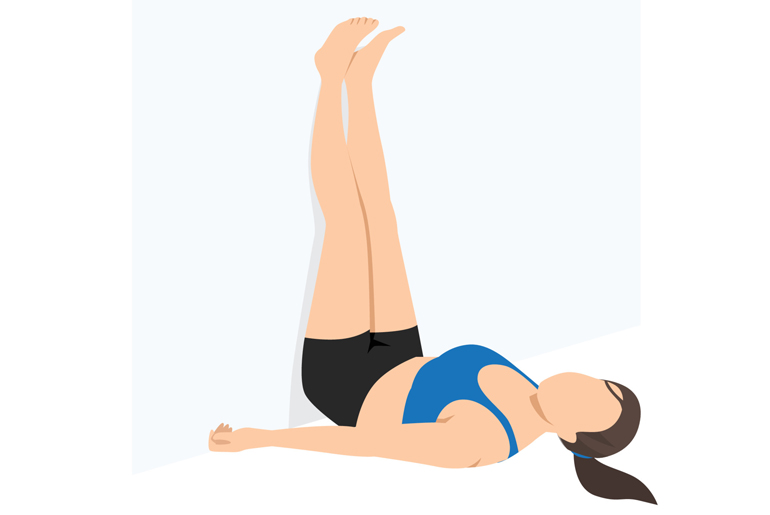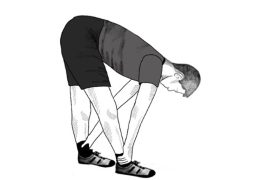Viparita Karani, also known as the Legs Up the Wall Pose, is a restorative yoga asana where you lie on your back with your legs extended vertically against a wall while your torso remains on the ground. This pose promotes relaxation, enhances blood circulation, and reduces stress. It helps alleviate tension in the legs, improves venous return, and can provide relief from headaches and lower back pain. Practicing Viparita Karani can also aid in calming the nervous system and improving overall mental clarity. It is an accessible pose for all levels and is often used as a gentle, restorative posture in yoga routines.
Guide to performing Viparita Karani Asana:
- Find a Wall: Sit next to a wall with one side of your body touching it.
- Lie Down: Gently lie on your back while swinging your legs up the wall. Your buttocks should be close to the wall, but they don’t need to be touching it.
- Adjust Your Position: If needed, slide your hips closer to the wall to get your legs straight up. You can use a folded blanket or bolster under your hips for added comfort and support.
- Relax Your Arms: Place your arms by your sides, palms facing up, or rest them on your abdomen. Keep your shoulders relaxed.
- Focus on Your Breath: Close your eyes and take deep, steady breaths. Try to relax your body and mind.
- Hold the Pose: Stay in this position for 5 to 15 minutes, depending on your comfort level. If this is your first time, start with a shorter duration and gradually increase it.
- Exit the Pose: To come out of the pose, gently bend your knees and roll to one side. Slowly rise to a seated position before standing up.
Viparita Karani is a restorative pose that can be practiced daily to enjoy its benefits.
Benefits of Viparita Karani Asana:
- Improves Circulation: Elevating the legs promotes venous return, helping blood flow back to the heart, which can relieve swelling in the legs and feet.
- Reduces Stress: The pose calms the nervous system, helping to lower stress levels and anxiety, promoting a sense of relaxation.
- Alleviates Lower Back Pain: By gently stretching the lower back and relieving pressure, this pose can help alleviate discomfort and tension in the lower back.
- Enhances Digestion: The inversion can stimulate digestion by increasing blood flow to the abdominal organs, potentially improving digestive function.
- Promotes Better Sleep: Regular practice can aid in relaxation, making it easier to fall asleep and achieve restful sleep.
- Soothes the Nervous System: The pose encourages a deep state of relaxation, which can help soothe an overactive mind and improve mental clarity.
- Supports Hormonal Balance: By improving circulation and reducing stress, it may contribute to better hormonal balance and overall well-being.
- Relieves Fatigue: The restorative nature of the pose can help alleviate feelings of tiredness and rejuvenate the body after physical activity or a long day.
- Improves Flexibility: Regular practice can enhance flexibility in the hamstrings and lower back, contributing to overall mobility.
- Boosts Mood: The calming effect of the pose can help improve mood and contribute to a more positive outlook.
Viparita Karani is a gentle, restorative pose suitable for all levels, making it an excellent addition to a yoga practice, particularly for winding down and enhancing relaxation.
Viparita Karani be integrated into a broader prenatal yoga:
Viparita Karani (Legs Up the Wall Pose) can be integrated into a broader prenatal yoga routine along with other supportive poses like Supta Bhadrasana, Marjaryasana-Bitilasana, and Savasana. Here’s how each pose fits into a prenatal yoga routine:
1. Viparita Karani (Legs Up the Wall Pose)
- Benefits: Improves circulation, reduces swelling in the legs, and promotes relaxation.
- Modification: Use props such as a bolster or pillow under the hips and keep the legs bent or supported on a chair, especially in the later stages of pregnancy.
2. Supta Bhadrasana
- Benefits: Opens the hips and groin, which can help ease discomfort in the pelvic region and support relaxation.
- Practice: Lie on your back with the soles of your feet together and knees bent out to the sides. Place pillows or bolsters under your knees for added support.
3. Marjaryasana-Bitilasana (Cat-Cow Pose)
- Benefits: Maintains spine flexibility, reduces back pain, and helps with proper posture.
- Practice: On hands and knees, alternate between arching your back (Cat) and dipping it towards the floor (Cow) while synchronizing with your breath.
4. Savasana (Corpse Pose)
- Benefits: Promotes deep relaxation and rest, essential for managing stress and supporting overall well-being during pregnancy.
- Modification: Use props such as cushions or bolsters to support your body and make the pose more comfortable, especially lying on your left side if lying on your back is uncomfortable.
Integrating These Poses
- Warm-Up: Start with gentle movements and stretches, including Marjaryasana-Bitilasana, to prepare the body.
- Main Sequence: Integrate Viparita Karani and Supta Bhadrasana for targeted relief and relaxation.
- Cool Down: End with Savasana to ensure deep relaxation and rest.
Duration of practicing this exercise:
The duration for practicing Viparita Karani (Legs Up the Wall Pose) can vary based on individual comfort and experience. Generally, the recommended duration is:
- Beginner Practitioners: Start with 1-5 minutes. As you become more accustomed to the pose, you can gradually increase the time.
- Intermediate to Advanced Practitioners: Aim for 5-15 minutes. This range is typical for those who are comfortable in the pose and are using it for relaxation or therapeutic benefits.
- For Relaxation: Some practitioners may hold the pose for up to 20 minutes if using it for deep relaxation and stress relief.
Modifications or precautions:
For those who need modifications or precautions while practicing Viparita Karani (Legs Up the Wall Pose), here are some suggestions:
Modifications
- Use a Supportive Prop: Place a folded blanket or bolster under your hips to provide additional support and reduce strain on your lower back. This can also make the pose more comfortable.
- Adjust the Distance from the Wall: If you find it challenging to get your legs up the wall, try placing your hips a little further from the wall. This adjustment can make it easier to get into the pose without overstraining.
- Bend Your Knees: If keeping your legs straight is uncomfortable, you can bend your knees and place your feet on the wall. This modification can help reduce pressure on the lower back and hips.
- Use a Chair: Place a chair against the wall and rest your legs on the seat. This variation can be more accessible and comfortable for those with limited flexibility.
- Practice with Legs Elevated on a Chair: Instead of directly against the wall, elevate your legs on a chair or ottoman to achieve a similar effect without requiring full inversion.
Precautions
- Avoid if Pregnant: Pregnant individuals should avoid this pose, particularly in the later stages, due to the potential pressure on the abdomen.
- Monitor Eye Pressure: If you have glaucoma or other eye conditions, avoid this pose or consult with your healthcare provider, as it can increase intraocular pressure.
- Consult for Back Pain: If you have severe lower back pain or injuries, consult a healthcare provider before attempting the pose, and use modifications as needed.
- Be Cautious with Blood Pressure: If you have high blood pressure or cardiovascular issues, consult your healthcare provider before trying this pose, as inversions can affect circulation.
- Support Your Neck: Ensure your neck is comfortably supported and aligned. If you experience any discomfort in the neck, use a folded towel under your head or avoid the pose altogether.
- Listen to Your Body: Always listen to your body and avoid pushing yourself into discomfort or pain. If you experience any negative symptoms, come out of the pose slowly and consult a yoga instructor or healthcare provider.
These modifications and precautions can help ensure a safer and more comfortable practice of Viparita Karani, accommodating different needs and health conditions.
Disclaimer:
The information contained in this article is for educational and informational purposes only and is not intended as a health advice. We would ask you to consult a qualified professional or medical expert to gain additional knowledge before you choose to consume any product or perform any exercise.







